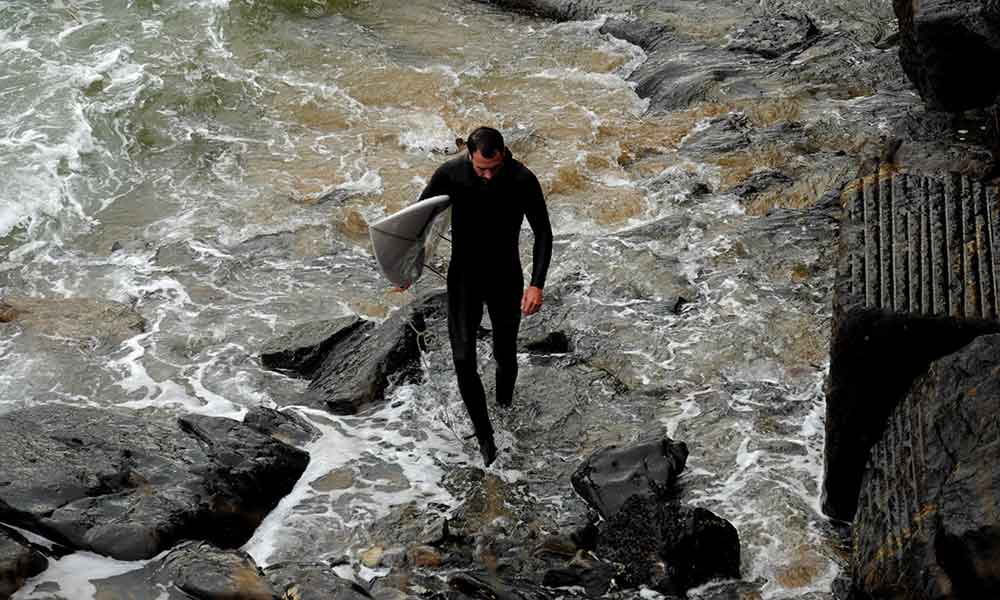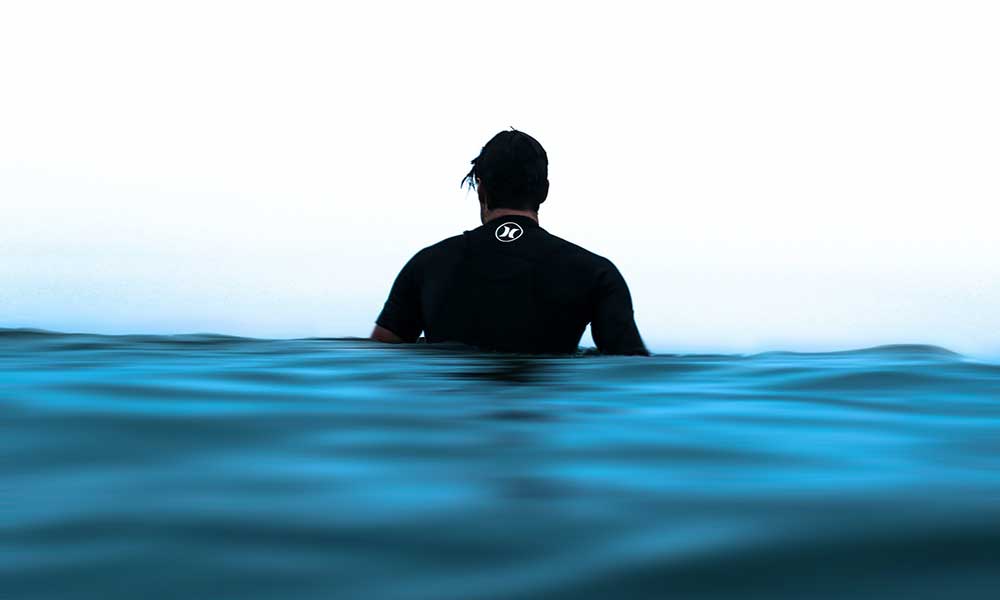The global wetsuit market is worth over $1 billion, and as more people are introduced to surfing and open water swimming, that number keeps climbing.
If you’re one of these wetsuit wearers and you have a few questions about how to wash, wear, clean, or repair your suit, or you’re wondering why it smells, doesn’t fit, and even how it works to begin with, keep reading!
What Is A Wetsuit?
A wetsuit is an item of clothing designed to protect the wearer in the ocean. Often made from natural rubber or neoprene, these suits are used by surfers, open-water swimmers, canoeists, scuba divers, snorkelers, and windsurfers.
The modern wetsuit dates back to 1952 when it was invented by Hugh Bradner, a physicist at the University of California, Berkeley.
Why Wear A Wetsuit?
Wetsuits protect you against cold water. That’s really all there is to it, but that’s a pretty important feature. After all, if you’re swimming or surfing in cold water for prolonged periods, there’s a high risk of hypothermia.
Wetsuits also aid with buoyancy, which will help you to scramble back to the board and to keep your head above water when open water swimming.
Who Invented The Wetsuit?
Hugh Bradner invented the wetsuit in 1952. The physicist used relatively fragile neoprene—a material that is still used in modern wetsuits—along with nylon. Improvements were steadily made thereafter and wetsuits became stronger, warmer, and more comfortable, as well as much more flexible.
Why Does My Wetsuit Smell?
Is your wetsuit a little stinky? There are a couple of potential reasons for this.
Firstly, if you’re leaving your suit in a closed space where it can’t breathe or air out, the smells from your body and the ocean will linger, fester, and make your neoprene smell worse than a jogger’s sock.
Secondly, as a wetsuit stays close to your skin, it soaks up all those body oils and odors and these become trapped in the suit. The more you sweat, the more intense these smells will be and, over time, the suit will start to stink.
Also, while it should go without saying, if you’re relieving yourself in your wetsuit and you don’t clean it properly, it’s going to smell pretty rank after a while.
How Does A Wetsuit Work?
A wetsuit is made from layers of insulating and waterproof material that protects you against the cold. Water cannot pass through the neoprene but if it works its way into the suit through any of the openings, it will be warmed by your body and this will aid the insulating properties of the suit.
Why Are Wetsuits Black?
Traditionally, rubber was always black because soot was added to stabilize it, turning the milky-white latex into a soot-black substance. A similar process occurred in the production of neoprene.
But it’s not just a default option. Black is also better at absorbing heat. The reason you should never wear all black on a summer’s day is the same reason that all-black wetsuits work so well. In addition, black may help to improve the durability of the suit by reducing oxidation, although these benefits are negligible at best.
If you’re not a big fan of black wetsuits, there are alternative colors available. Just remember to stay away from sharply contrasting colors in areas known for shark attacks and don’t sacrifice function for style.
How Long Do Wetsuits Last?
The lifespan of your wetsuit will depend on a number of factors, including the quality, the materials, how much you use it, and how well you treat it.
Generally speaking, they will last for between 4 and 10 years on average, but if you buy a cheap wetsuit, don’t maintain it, and use it several times a week, you’ll be lucky to get a year out of it.
How Do I Prolong the Life of My Wetsuit?
That wetsuit won’t last forever, but if you take the right steps, you’ll get a good 10 years out of it:
- Buy the best wetsuit you can afford. Focus on value and quality, as opposed to simply buying the most expensive one.
- Repair small tears as soon as they appear.
- Wash your wetsuit after surfing.
- Be careful when putting on and removing your wetsuit.
- Stay away from chlorine pools where possible.
- Rinse as often as you can to remove saltwater.
- Store and transport your wetsuit carefully (see below)
- Don’t leave your wetsuit out in the sun.
How To Store A Wetsuit?
Store your wetsuit in a cool dry place and don’t be tempted to leave it out in the sun to “dry”. Your garage or basement will be ideal, but you can also fold it away in a closet. If it is placed in direct sunlight, the neoprene will begin to break down and it won’t last as long as it should.
What Are Wetsuits Made Of?
Most wetsuits are made from a material known as neoprene. It is the perfect material for wetsuits as it provides thermal insulation while also protecting against sun damage, abrasions, and even attacks from small animals. As noted above, it even provides a degree of buoyancy.
It’s not perfect, though. Neoprene manufacturing leaves a sizeable carbon footprint and so many surfers and manufacturers are turning their backs on the material. There are now numerous sustainable and eco-friendly options on the market, including the Yulex series of wetsuits from Patagonia, which feature 100% natural rubber.
Do Wetsuits Keep You Warm?
Yes, the main purpose of a wetsuit is to keep you warm and it achieves this by blocking out the cold and locking in your body heat.
How Much Does A Wetsuit Cost?
As with any other item of clothing, the cost of a wetsuit can differ considerably. There are multiple factors at play here, including:
- The Materials: Does it use neoprene or natural rubber? Does it contain any other materials or features that could increase the cost?
- The Seams and Stitching: How well is the wetsuit stitched together and what seams are used? Is it strong, flexible, and well-made?
- The Brand: Is it a well-known and premium brand that can afford to charge higher margins or is it sold by a generic manufacturer based in China?
How To Wash A Wetsuit?
Your wetsuit should be rinsed well and often to remove salt and other debris. After use, it must be washed with a wetsuit shampoo, which contains ingredients that will clean your suit without harming it.
To learn more, check out our guide to cleaning a wetsuit after surfing.
Where To Buy Wetsuits?
You can buy wetsuits from many major online retailers. If you know what you’re looking for and have experience wearing and owning wetsuits, this is the best way to buy. You should get more bang for your buck and you’ll have a wider range of wetsuits to choose from.
Once you find one that you like, be sure to compare the prices with other retailers and double-check the returns policy just in case there is an issue.
If you’re new to wetsuits and are not sure what you need, it’s best to buy one in person. That way, you can try it on and judge whether it’s a good fit or not. The shop assistant can also point you in the right direction and answer any questions that you have.
What Wetsuit Is Best For Southern California?
In Southern California, a 3/2 full suit with boots should be enough to cover you through the fall and winter. In the summer, you can stick with a spring suit.
What is the Stretchiest Wetsuit?
O’Neil makes some very stretchy wetsuits and has always been at the forefront of innovation in this industry. Check out the O’Neil Hyperfreak 5 if you want a super-stretchy wetsuit.
Which Wetsuit Is Best For Surfing?
All wetsuits can be used for surfing. They are designed to provide a snug fit while allowing the user to move freely, and so you should be able to stand, paddle, and move with a great degree of freedom.
The only thing you need to think about is how thick it should be, whether it’s in your budget or not, and if it’s high quality.
Some of the best wetsuits available right now include ones made by Billabong, O’Neill, Patagonia, and Rip Curl.
Does A Wetsuit Keep You Dry?
The main purpose of a wetsuit is not to keep you dry, but to keep you warm. If you want to stay completely dry, you’ll need a drysuit, which hangs a little looser from the body but uses inflator valves to keep a layer of air between the suit and the body.
How To Dry A Wetsuit?
Hang the suit on a plastic hanger in a shower or garage. Double it up and return after a day to turn the suit inside out, making sure that it is dry both inside and out.
Do Wetsuits Help You Float?
Yes, a wetsuit should provide some additional buoyancy and that will help you to stay afloat in the water.
Should I Wear Anything Under the Wetsuit?
It’s entirely up to you! Some surfers like to wear additional clothing under their suits, others prefer to stay naked. There are benefits to both.
If you go nude, you don’t have to worry about bunching or overheating. However, if you need to remove the wetsuit at the beach, and you don’t have anything underneath, you’ll be exposing yourself to fellow surfers, swimmers, and beachgoers. This is usually more of a problem for women than it is for men, but there are other things to consider, as well.
For instance, wearing a rash guard underneath your suit will provide extra protection against the cold and the sun. It will also help you with its intended purpose, which is to prevent rashes caused by chafing.
If you’ve decided to wear something under your suit but you’re not sure what, check out the following options for males and females:
What To Wear Under a Wetsuit as a Male?
Diving shorts are a great option for male surfers. These skin-tight neoprene shorts will protect your lower half while a rash guard can cover your upper half. If you’re not a fan of shorts, opt for briefs instead.
What To Wear Under a Wetsuit as a Female?
Diving shorts are also available for women and these can be worn with rash guards and sleeveless tops. Alternatively, a jump suit will cover everything.
What Thickness Wetsuit Do I Need?
Wetsuit thickness is mostly seasonal and will change depending on the water and air temperature.
In the winter, thicker is better and you should opt for a 6/5/4 or 5/4/3 hooded suit. In the fall and spring, 4/3 full suits are usually sufficient. In the summer, you can survive with a 3/2 spring suit. It’s just enough protection to keep you snug while also guarding against sun damage.
Personal preference also plays a role.
If you’re the sort of person who wears a jacket in the summer and hates anything that’s less than “balmy”, you may want to opt for a thicker wetsuit. Don’t go too thick, though. You don’t want to overheat.
Are Back Zip Or Front Zip Wetsuits Better?
To the uninitiated, a back-zip wetsuit sounds like a logistical nightmare—like putting sunscreen on your back. But these wetsuits are actually the easiest to put on. They have arm holes in the front and so you don’t need to twist and contort your shoulders to get inside.
As for the actual zip, it’s attached to a piece of string so you don’t need any help putting the suit on.
Back-zip wetsuits are the go-to option for beginners and they are also favored by many experienced surfers. They are not perfect, though.
Front-zip wetsuits are less likely to allow water inside and they are also more flexible. If too much water gets inside the suit, it will affect the temperature regulation.
The “better” option comes down to personal preference. Do you want the added protection provided by front-zip wetsuits or do you prefer the ease of use and comfort afforded by back-zip suits?
How Tight Should A Wetsuit Be?
The perfect-fitting wetsuit strikes a fine balance between “so snug it’s like a second skin” and “loose enough to allow for a full range of movement”.
It shouldn’t restrict your breathing or your blood flow and you need to be able to bend your knees and elbows, as well.







